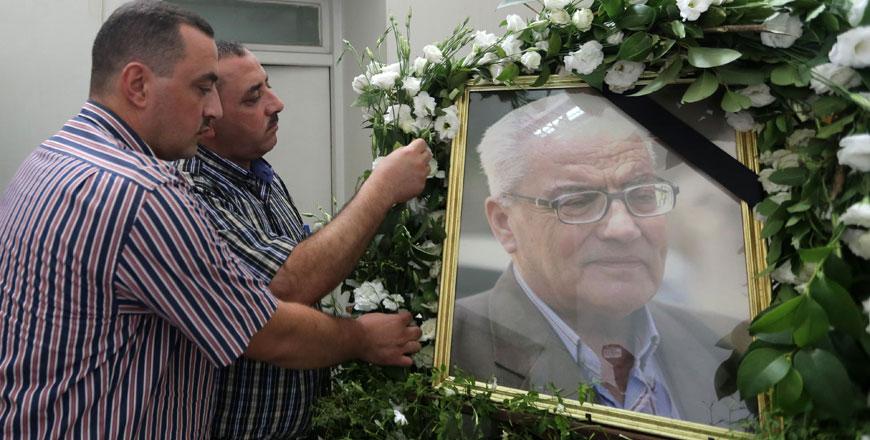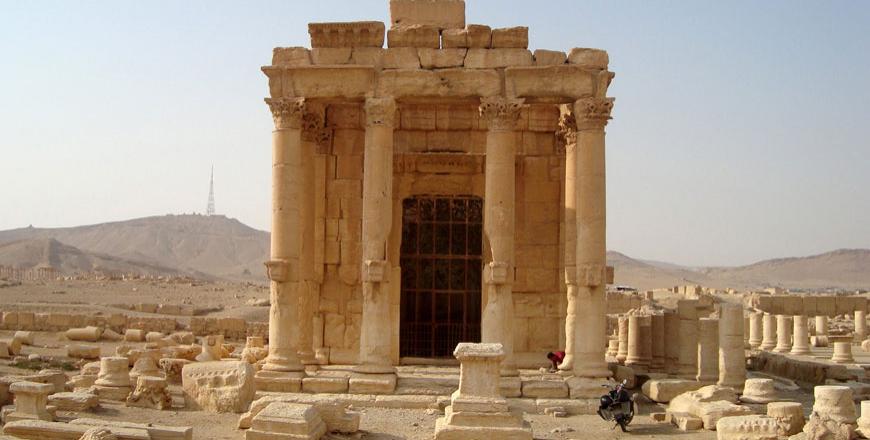You are here
Daesh mutilated body of famed Syrian archaeologist — family
By AFP - Aug 23,2015 - Last updated at Aug 23,2015

The sons of Khaled Al Assaad, the late 82-year-old retired chief archaeologist of the ancient Syrian city of Palmyra, Omar (left) and Mohammad display a portrait of their father during a ceremony in his memory at the National Museum on Sunday in the Syrian capital Damascus (AFP photo)
DAMASCUS — Daesh militants mutilated the body of a famed Syrian archaeologist after killing him execution-style in the ancient city of Palmyra last week, his family said Sunday.
Khaled Al Assaad, Palmyra's antiquities chief for 50 years, was on Tuesday beheaded by Daesh militants who tied his body to a post before hanging it in the city's ruins, amid international outrage.
"Residents of Palmyra told me that IS [Daesh] had cut up my father's body into pieces," said Mohammad Al Assaad, one of Khaled's sons, said at a wake held Sunday at Damascus National Museum.
"My father used to always say, 'I'll die standing up, like the palm tree of Palmyra'," Mohammad told AFP.
He added that despite threats from jihadists, his father had refused to leave Palmyra.
Syria's national antiquities chief Mamoun Abdulkarim gave a similar account.
"Khaled's cousins, who also work in antiquities, told me that the group removed his body from the pole and mutilated it," said Abdulkarim.
Omar Al Assaad, another of Khaled's sons, said his father had attempted to hide from Daesh in Palmyra after the jihadists overran the city on May 21.
But Khaled and his son Walid, the current head of antiquities in Palmyra, were detained by Daesh and questioned about stores of gold and artefacts.
Though they released them both after one week, the jihadists later recaptured the 82-year old chief archaeologist.
The family was shocked to see him dragged out to Palmyra's public square to be murdered, Omar said.
The family fled to the government-controlled city of Homs, and then on to Damascus.
The killing is one of hundreds that have been carried out by Daesh in and around Palmyra, a UNESCO world heritage site famed for its well-preserved Greco-Roman ruins.
So far, Palmyra's most famous sites have been left intact, though there are reports Daesh has mined them, and the group reportedly destroyed a famous statue of a lion outside the city's museum in June.
Most of the pieces in the museum were evacuated by antiquities staff before Daesh arrived, though the group has blown up several historic Muslim graves.
Related Articles
BEIRUT — The Daesh terror group has beheaded the 82-year-old retired chief archaeologist of Palmyra, who refused to leave the ancient city w
DAMASCUS — The son of a Syrian archeologist who was beheaded by Daesh militants in ancient Palmyra is on a mission to give his father a "dig
BEIRUT — The Daesh terror group has blown up a famed temple in Syria's ancient Palmyra, in an act the UN condemned as a war crime and an "im
















